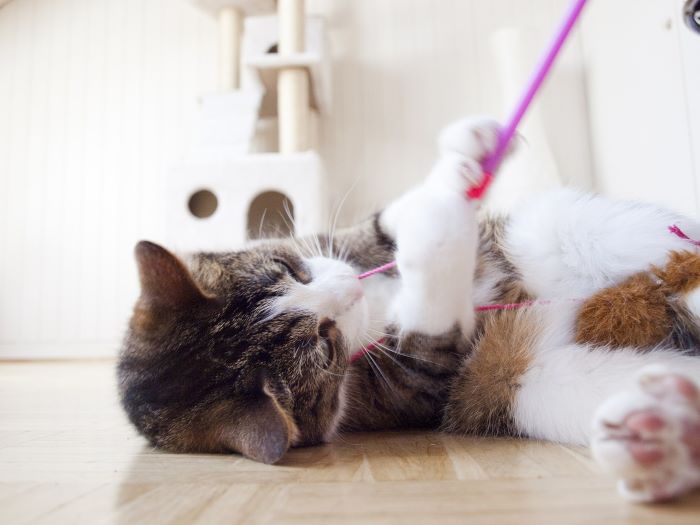Cats need some excitement in their lives to ensure their physical and mental well-being—especially indoor pets that are left alone at home all day. With a little thought and commitment, you can give your cat a fun home life. Playing games together is a positive way of interacting with your cat, but you should also encourage him to play alone.
Play is an important outlet for your cat’s excess energy. Any cat that is deprived of opportunities to hunt and stalk is likely to become bored and stressed, and this may lead to behavioral problems.
The mental and physical stimulation derived from play is just as important to adult cats as it is for kittens. Most cats, especially if neutered, will retain their sense of playfulness as they get older.
Lack of stimulation can be a real problem with indoor cats, which after a dull day with no company will constantly pester their owners for attention when they get home. Outdoor cats have a riskier but more stimulating and active lifestyle.
With plenty of space to run and jump around and exposure to new experiences, they can give free rein to their natural instincts for exploring, chasing, and hunting. Even indoors, a cat needs to let off steam regularly.
Often, this takes the form of a “crazy moment,” when the cat rushes around the room, leaping on to furniture and climbing the curtains before bolting off. This is perfectly natural behavior, but uncontrolled sessions like this run the risk of damaging your home and causing injury to your cat. To prevent manic bursts of activity, channel your cat’s predatory instincts with interactive toys and constructive play.
A Variety of Toys
Cats like toys that appeal to their chasing, stalking, and pouncing instincts, so satisfy your cat’s need to hunt by providing him with a convincing substitute.
Interactive toys, such as play wands with a dangling feather or catnip mouse, give your cat something to grab or bat with his paws, or to chase after when trailed along the ground. A play wand also keeps your hands at a safe distance from claws and teeth when your cat attacks his “prey.”
You should not be the sole source of fun for your cat, so be sure to offer him toys that he can play with on his own. Toys that move, have an interesting texture, or are scented with catnip are most likely to catch his attention.
Most cats find windup or battery-operated toys that move around the floor particularly exciting. Make sure that toys are in good condition, with no pieces that could fall off and be swallowed.
You should supervise your cat’s use of anything that could be chewed or shredded. Bits of string and fabric can cause intestinal blockages, while sharp edges can damage a cat’s mouth.
Simple Pleasures
You do not need to buy your cat expensive accessories or toys. Cats can make their own amusement from simple, everyday items such as crumpled newspaper, thread spools, pencils, pinecones, corks, and feathers.
Cats love hiding, so provide yours with somewhere to play hide-and-seek, such as an old cardboard box or a paper bag. Never let a cat play with a plastic bag—a cat can suffocate inside or strangle itself if it gets trapped in the handles.
Make sure that curtain and window-blind cords are not allowed to dangle within easy reach of your cat, since he is likely to view them as a great opportunity to play. As agile as your cat may be, he could easily become entangled and strangle himself.
Keeping Your Cat Stimulated
One way to make playtime with your cat more interesting is to teach him a new trick. Unlike a dog, which will learn tricks to please its “pack leader,” a cat needs a different motivator—food.
The best time to teach your cat is just before a meal, when he is hungry. Select a quiet spot with no distractions, but do not spend more than a few minutes on each training session. You may need to repeat the training a few times each day for several weeks, depending on your cat’s age and the difficulty of the trick.
Reward your cat’s progress in getting the trick right with small treats and give him plenty of praise. Your cat will be happy to participate only if he is having a good time: Do not try to force him to do something he does not want to, and do not get upset if he decides that he is not interested.
Even if your cat is not ready to cooperate by learning tricks, you can still have fun with food by buying or making a puzzle feeder. Your cat has to paw and nose the feeder to make the food fall out. You can also scatter dry food around the house so that he has to “hunt” for it, instead of just eating from a bowl.
Toy Parade
There is a wide variety of playthings available for cats. Most toys are designed to stimulate the cat’s desire to hunt and stalk prey. Suitable toys include small, lightweight balls and bean bags, felt or rope pretend mice, pom-poms, and feathers.
Many pet stores also stock catnip-scented toys and hollow balls in which a treat or small amount of food can be hidden. A scratching post, play station, or cat gym will stimulate the cat’s natural inclination to climb on to a higher surface.
Multi activity centers provide plenty of variety for your cat, with a cozy hiding place, scratching post, somewhere to sit, and hanging toys to play with.
 Kitten playing with a cat toy
Kitten playing with a cat toy

